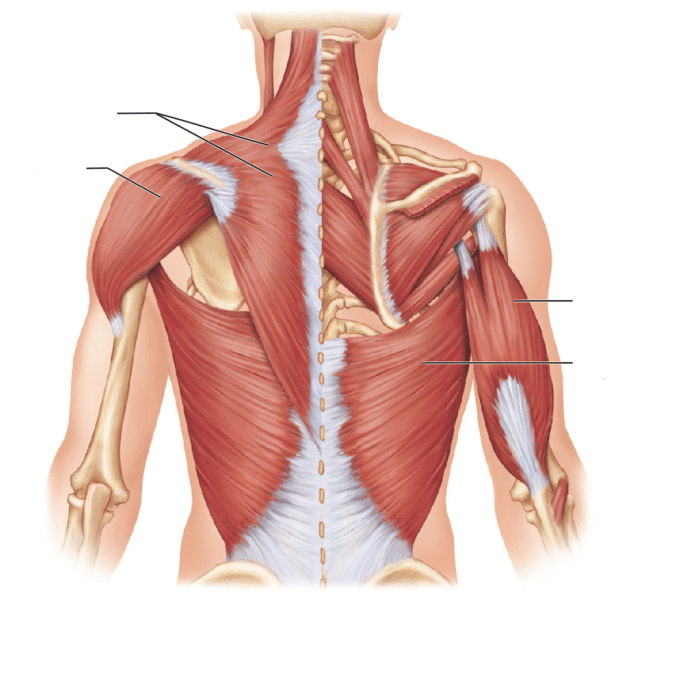Label the superficial and intermediate muscles of the posterior trunk – In this comprehensive guide, we embark on an exploration of the superficial and intermediate muscles of the posterior trunk, unraveling their intricate anatomy and functional significance. Delving into their location, origin, insertion, innervation, and function, we will illuminate their essential roles in maintaining posture, facilitating movement, and safeguarding against common injuries.
Our journey begins with an overview of the superficial muscles, meticulously examining each muscle’s unique characteristics and contributions to the posterior trunk’s structural integrity and mobility. Subsequently, we will delve into the intermediate muscles, exploring their deeper anatomical relationships and their interplay with the superficial muscles.
Superficial Muscles of the Posterior Trunk: Label The Superficial And Intermediate Muscles Of The Posterior Trunk

The superficial muscles of the posterior trunk are located beneath the skin and superficial fascia. They are responsible for various movements of the trunk, including extension, rotation, and lateral flexion.
Trapezius, Label the superficial and intermediate muscles of the posterior trunk
- Location: Posterior neck and upper back
- Origin: External occipital protuberance, nuchal ligament, spinous processes of C7-T12 vertebrae
- Insertion: Lateral third of clavicle, acromion process of scapula, spine of scapula
- Innervation: Spinal accessory nerve (CN XI)
- Function: Elevation, retraction, and rotation of scapula
Latissimus Dorsi
- Location: Posterior trunk and back
- Origin: Spinous processes of T7-L5 vertebrae, iliac crest, lower ribs
- Insertion: Medial border of humerus
- Innervation: Thoracodorsal nerve (C6-C8)
- Function: Extension, adduction, and medial rotation of arm
Intermediate Muscles of the Posterior Trunk
The intermediate muscles of the posterior trunk lie deep to the superficial muscles. They are responsible for movements such as spinal extension and rotation.
Splenius Capitis
- Location: Posterior neck
- Origin: Spinous processes of T3-T6 vertebrae
- Insertion: Mastoid process of temporal bone, occipital bone
- Innervation: Dorsal rami of C3-C8 nerves
- Function: Extension and rotation of head
Splenius Cervicis
- Location: Posterior neck
- Origin: Spinous processes of T3-T6 vertebrae
- Insertion: Transverse processes of C1-C3 vertebrae
- Innervation: Dorsal rami of C3-C8 nerves
- Function: Extension and rotation of neck
Comparison of Superficial and Intermediate Muscles

The superficial and intermediate muscles of the posterior trunk differ in their location, function, and innervation.
Superficial muscles are located closer to the skin and are responsible for larger movements of the trunk. They are innervated by nerves from the cervical and thoracic spinal cord.
Intermediate muscles are located deeper to the superficial muscles and are responsible for finer movements of the spine. They are innervated by nerves from the dorsal rami of the spinal cord.
Clinical Significance

The superficial and intermediate muscles of the posterior trunk are involved in various clinical conditions.
Strain or tear of the latissimus dorsi muscle can occur due to excessive lifting or throwing. Weakness of the trapezius muscle can lead to drooping of the shoulder and difficulty in raising the arm.
The intermediate muscles of the posterior trunk can be affected by spinal injuries, such as whiplash or herniated discs. These injuries can cause pain, stiffness, and weakness in the back.
Top FAQs
What are the key differences between superficial and intermediate muscles of the posterior trunk?
Superficial muscles are located closer to the skin’s surface, while intermediate muscles lie deeper within the trunk. Superficial muscles are primarily responsible for initiating movement, whereas intermediate muscles contribute to maintaining posture and stabilizing the trunk.
How do the superficial and intermediate muscles contribute to posture?
These muscles work in concert to maintain an upright posture by balancing the forces acting on the trunk. They prevent excessive forward or backward bending, ensuring proper alignment and stability.
What are some common injuries involving the superficial and intermediate muscles of the posterior trunk?
Strains, sprains, and muscle tears are common injuries affecting these muscles. These injuries can result from sudden movements, improper lifting techniques, or overuse.